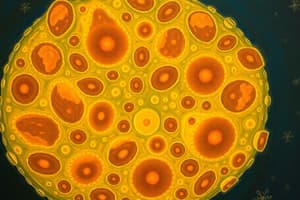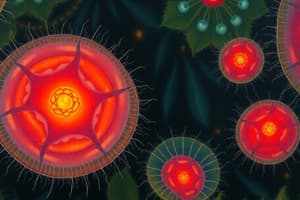Podcast
Questions and Answers
What type of cells does meiosis produce within sporangia?
What type of cells does meiosis produce within sporangia?
haploid cells
What can the haploid cells developed from spores within sporangia become?
What can the haploid cells developed from spores within sporangia become?
- Muscle cells
- Hepatic cells
- Swarm cells (correct)
- Sperm cells
Swarm cells and myxamoeba act as somatic cells.
Swarm cells and myxamoeba act as somatic cells.
False (B)
Under unfavorable conditions, certain amoeboid cells release a chemical signal called ______.
Under unfavorable conditions, certain amoeboid cells release a chemical signal called ______.
Match the following terms with their descriptions:
Match the following terms with their descriptions:
What is the primary mode of reproduction for algae?
What is the primary mode of reproduction for algae?
Dinoflagellates can exhibit both autotrophic and heterotrophic lifestyles.
Dinoflagellates can exhibit both autotrophic and heterotrophic lifestyles.
Diatoms move by means of gliding facilitated by the secretion of slimy materials from their ____.
Diatoms move by means of gliding facilitated by the secretion of slimy materials from their ____.
Match the algae subgroup with its characteristics:
Match the algae subgroup with its characteristics:
What are the general characteristics of Protista?
What are the general characteristics of Protista?
How do Protists obtain nutrients?
How do Protists obtain nutrients?
Protists are classified into distinct kingdoms by all biologists.
Protists are classified into distinct kingdoms by all biologists.
How do amoebas move and feed?
How do amoebas move and feed?
Foraminiferans are also known as 'hole bearers' and have __________ pseudopods.
Foraminiferans are also known as 'hole bearers' and have __________ pseudopods.
What are the shells of Foraminiferans made of?
What are the shells of Foraminiferans made of?
Flashcards are hidden until you start studying
Study Notes
PROTISTA: CHARACTERISTICS
- All protists are eukaryotic organisms
- Cell organization consists of unicellular, multicellular, or colonial
- Live in aquatic environments
- Some protists are more closely related to plants, fungi, or animals, but they do not belong to these groups
- Size varies from microscopic (nanometers) to macroscopic (meters)
PROTISTAS DIVERSITY
- Locomotion:
- Move by means of cytoplasmic extension (pseudopodia, axopodia)
- Glide over surfaces
- Flex their body
- Wave cilia or flagella
- Some use a combination of these methods
- Obtaining nutrients:
- Autotrophic (most protists)
- Heterotrophic (absorbing nutrients, ingesting food)
- Some use a combination of autotrophic and heterotrophic modes
- Interaction with other organisms:
- Free-living or associated with other organisms (mutualism, commensalism, symbiotic, parasitic)
PROTISTA: GROUP PROTOZOA
- Characteristics:
- Heterotrophic and ingest food as animals do
- Not multicellular
- Examples: Amoebas, Forams, Actinopods, Zooflagellates, Apicomplexans, Ciliates
PROTISTA: PROTOZOA - AMOEBAS
- Characteristics:
- Unicellular, freshwater, marine ecosystem, or other organism's body
- Flexible, asymmetric body that can change shape
- Move by pushing out cytoplasmic projections (pseudopodia)
- Pseudopodia also serve in ingestion of food through phagocytosis
- Reproduce asexually by binary fission
- Importance:
- Entamoeba histolytica causes severe dysentery and intestinal problems
PROTISTA: PROTOZOA - FORAMS
- Characteristics:
- Have reticulating pseudopods, fine strands of cytoplasm
- Typically produce a test or shell (calcium carbonate or agglutinated sediment particles)
- Shells are usually less than 1 mm in size, but some are larger
- Importance:
- Fossil assemblages are useful for biostratigraphy and finding potential oil deposits
- Bioindicators in coastal environments, including indicators of coral reef health
PROTISTA: PROTOZOA - ACTINOPODS
- Characteristics:
- Marine plankton organisms with long, filamentous cytoplasmic projections (axopods)
- Axopods strengthened by a cluster of microtubules
- Feed on unicellular algae
- Some contain algal endosymbionts
- Secrete elaborate and beautiful glassy shells (radiolarians)
- Shells settle on the ocean floor, becoming an ooze
PROTISTA: PROTOZOA - ZOOFLAGELLATES
- Characteristics:
- Body is spherical or elongated with a single central nucleus
- Move rapidly by means of one or two whiplike flagella
- Heterotrophic, some obtain food in amoeboid style
- Some are free-living, while others are endosymbionts
- Examples: Trichonymphs, zooflagellates in termites and wood-eating cockroaches
- Importance:
- Parasitic zooflagellates cause disease (e.g., Trypanosoma sp.)
PROTISTA: PROTOZOA - APICOMPLEXANS
- Characteristics:
- Parasites in animals, including humans
- Infectious stage in life cycle is in the form of tiny cells (sporozoites)
- Apicomplexans have a complex specialized microtubules for penetrating host cells and tissues
- Apicoplast, a nonphotosynthetic plastid, helps in synthesizing fatty acids
- Life cycle involves both sexual and asexual stages
- Importance:
- Plasmodium sp. causes malaria
PROTISTA: PROTOZOA - CILIATES
- Characteristics:
- Move and feed with cilia
- Diet varies among them, but mostly ingest bacteria or tiny protists
- Cilia help draw food into a simple opening (oral groove)
- Water regulation is controlled by contractile vacuoles
- Two types of nuclei: macronuclei and micronuclei
- Asexual reproduction by binary fission
- Sexual reproduction by conjugation
PROTISTA: ALGAE
- Characteristics:
- Autotrophic and their size varies from unicellular to multicellular
- Habitats are restricted to damp and wet environments
- Mode of reproduction may involve both sexual and asexual types
- Criteria for classification include photosynthetic pigments, flagella, energy reserves, cell wall composition, and chloroplast structure
PROTISTA: ALGAE - EUGLENOIDS
- Characteristics:
- Unicellular, flexible, and changeable body
- Two flagella: one long and whiplike, and one short
- Contain chloroplasts and undergo photosynthesis
- Energy reserves are stored as paramylon
- Some perform heterotrophic lifestyle
- Reproduce asexually by longitudinal cell division
PROTISTA: ALGAE - DINOFLAGELLATES
- Characteristics:
- Unicellular, with intracellular shells of interlocking cellulose plates
- Have two flagella: one wrapped around the transverse groove and one in a longitudinal groove
- Photosynthetic pigments include chlorophyll a, chlorophyll c, and fucoxanthin
- Energy reserves are stored as oils or polysaccharides
- Some are endosymbionts, residing within the bodies of marine invertebrates
- Reproduction is primarily asexual with longitudinal cell division
PROTISTA: ALGAE - DIATOMS
- Characteristics:
- Unicellular, with a unique cell wall deposited with silicates
- Move by gliding, facilitated by the secretion of slimy materials
- Photosynthetic pigments include chlorophyll a, chlorophyll c, and fucoxanthin
- Energy reserves are stored as oils or water-soluble carbohydrates
- Reproduce commonly by asexual reproduction, dividing into two halves of the shell
- Sexual reproduction involves the fusion of gametes, forming a zygote
PROTISTA: ALGAE - GOLDEN ALGAE
- Characteristics:
- Unicellular or colonial, biflagellated organisms
- Physical appearance is typically like an amoeboid cell
- Tiny scales of silica or calcium carbonate may cover the cells
- Chloroplasts contain photosynthetic pigments, giving the algae a golden and brown color
- Energy reserves are stored as oils or carbohydrates
- Reproduction is primarily asexual, involving the production of flagellated, motile spores
PROTISTA: ALGAE - BROWN ALGAE
-
Characteristics:
- Multicellular, commonly known as seaweeds
- Body shape varies from branched filament to fleshy or thick and flattened branches
- Buoyancy mechanism is supported by the presence of numerous gas-filled floats (bladders)
- Photosynthetic pigments include chlorophyll a, chlorophyll c, and fucoxanthin
- Energy reserves are stored as laminarin
- Reproduction involves both asexual and sexual modes, with alternation of generation### Protista: Green Algae (Chlorophyta)
-
Autotrophic and possess diverse body shapes, existing in unicellular, multicellular, multinucleate, and colonial forms.
-
Some interact with other organisms symbiotically, and a few grow as dual organisms with fungi called lichens.
-
Share similarities with plants in:
- Cell wall composition: cellulose
- Energy reserves: starch
- Photosynthetic pigments: chlorophyll a, chlorophyll b, and carotenoids
-
However, algae are separated from the plant kingdom because their multicellular group does not have cells that differentiate into tissues.
-
Most green algae move by means of flagella, with some producing flagellated cells in their life cycle, and a few being totally non-motile.
Diversity of Shapes in Chlorophyta
- Pediastrum
- Closterium
- Spirogyra
- Micrasterias
- Staurastrum
- Cosmarium
Reproduction in Green Algae
- Occurs both asexually and sexually, with most exhibiting alternation of generation.
- Asexual reproduction involves:
- Binary fission for unicellular organisms
- Fragmentation for multicellular organisms
- Asexual spores are produced by mitosis, and if they are flagellated and motile, they are called zoospores.
Protista: Red Algae (Rhodophyta)
- Main group exhibits multicellular characteristics, composed of complex, interwoven filaments that are delicate and feathery.
- Some are flattened sheets of cells.
- Majority attach to rocks or any substrate by their holdfast.
- Reproduction process is complex, involving alternation of generation between sexual and asexual stages.
- Sexual reproduction produces non-flagellated gamete cells.
- Photosynthetic pigments contain:
- Phycoerythrin
- Phycocyanin
- Chlorophyll a
- Chlorophyll b
- Carotenoids
- Energy reserves are stored as floridean starch.
Importance of Red Algae
- Cell walls contain thick and sticky polysaccharides called agar, used as:
- Food thickener
- Basic component in culture medium
- Carrageenan, a polysaccharide extracted from red algae, is used as:
- Food additive in stabilizing chocolate milk, ice creams, and other foods
- Red algae are a source of:
- Vitamins A and C
- Minerals for humans
- Ecologically important in building coral reefs ecosystems.
Protista: Molds
- General characteristics:
- Saprophytic, consisting of fungus-like bodies and threadlike structures called hyphae
- Cell containing centrioles and cell walls built from cellulose instead of chitin
- Habitats are restricted to wet and damp areas
- Members of molds include:
- Plasmodial slime molds (Myxomycota)
- Cellular slime molds (Acrasiomycota)
- Water molds (Oomycota)
Plasmodial Slime Molds (Myxomycota)
- Protists that have a different type of feeding process by performing plasmodium, a multinucleate mass of cytoplasm.
- Plasmodium is slimy and creeps along wet substances, forming a network of channels that cover large surface areas.
- Under unfavorable conditions, the plasmodium crawls to exposed surface areas and initiates reproduction process.
- Stalked structure starts to develop and produce sporangia.
- Within sporangia, meiosis occurs to produce haploid cells that are resistant towards unfavorable conditions.
- Example: Physarum polycephalum
Plasmodial Slime Molds – Life Cycle
- See diagram
Cellular Slime Molds (Acrasiomycota)
- Characteristics in between amoeba and plasmodial slime mold.
- In their feeding stage, they exist as individual amoeboid cells that behave as separate, solitary organisms.
- Each amoeboid cell creeps on damp, wet surfaces and ingests bacterial cells, spores, and organic matters.
- Amoeboid cells reproduce asexually by binary fission and become haploid cells.
- Under unfavorable conditions, certain amoeboid cells release a chemical signal, cyclic adenosine monophosphate (cAMP), causing them to aggregate.
- The multicellular unit will creep for a short distance and settle down as a pseudoplasmodium or 'slug'.
- The slug eventually develops a stalked fruiting body that bears asexual spores.
- Example: Dictyostelium discoideum
Cellular Slime Molds – Life Cycle
- See diagram
Water Molds (Oomycota)
- Superficially resemblance with fungi in terms of their body structure and cell wall composition.
- Body consists of threadlike structures called hyphae, which are coenocytic and form a mycelium that grows on organic materials.
- Cell wall may be composed of cellulose, chitin, or both.
- Reproduce asexually under favorable conditions, producing tiny biflagellate zoospores.
- Under unfavorable conditions, sexual reproduction is triggered, forming a zygote that eventually becomes a thick-walled structure called oosphere.
- Example: Phytophthora infestans
Water Molds – Life Cycle
- See diagram
Studying That Suits You
Use AI to generate personalized quizzes and flashcards to suit your learning preferences.




